Financial Reporting Analysis: Purpose, Framework, and IFRS
VerifiedAdded on 2021/01/02
|15
|2947
|65
Report
AI Summary
This report provides a comprehensive overview of financial reporting, beginning with its context and purpose, and delving into the conceptual and regulatory framework that underpins it. It examines the benefits of financial reporting for various stakeholders, including owners, employees, creditors, and the government, highlighting its value in meeting organizational objectives and fostering growth. The report then explores financial statements, including their interpretation through ratio analysis, and differentiates between IAS and IFRS. An evaluation of the benefits of IFRS and the varying degrees of compliance are also discussed, offering a complete understanding of the subject. The report emphasizes the importance of financial reporting in providing transparent and reliable financial information to support decision-making and ensure accountability within organizations.
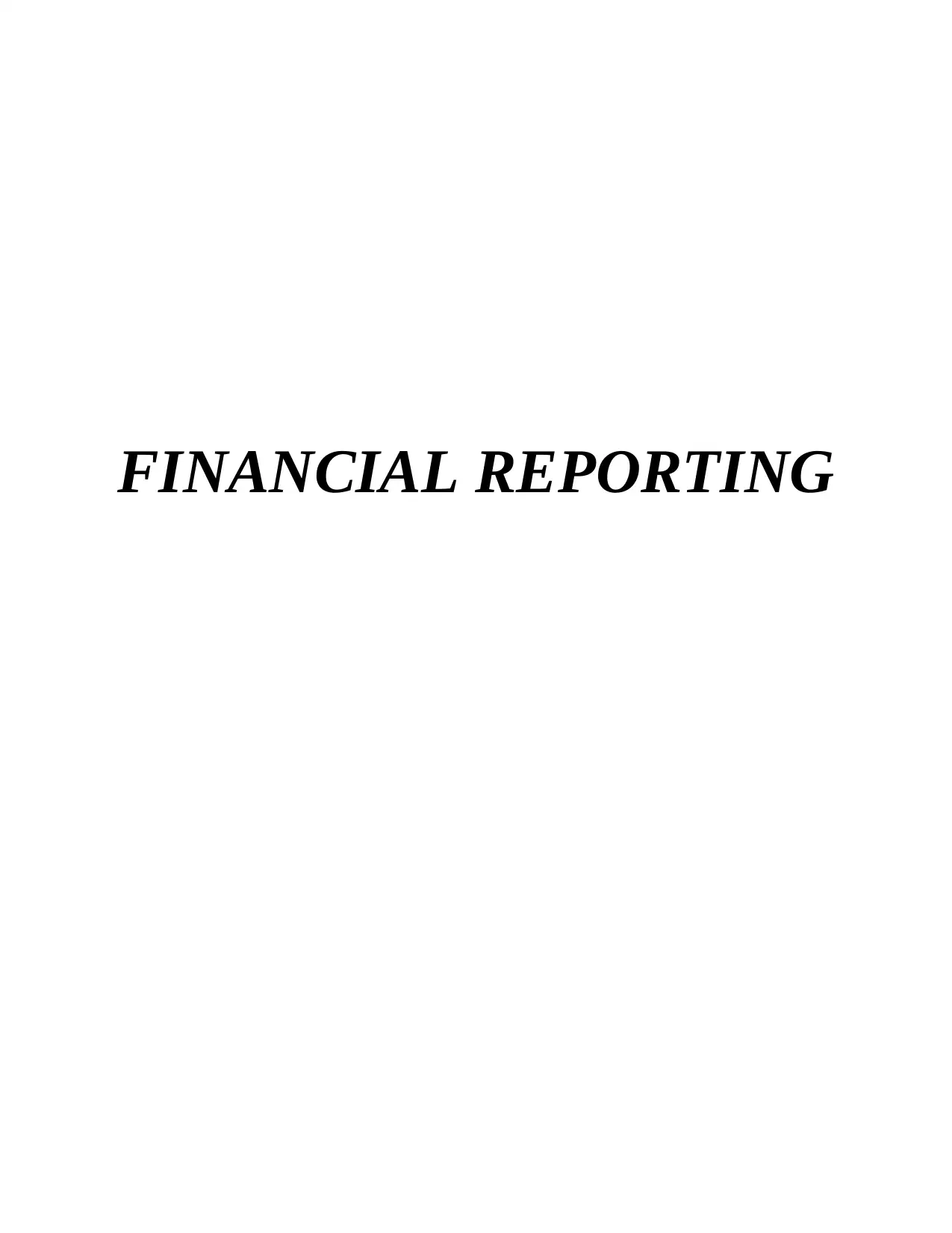
FINANCIAL REPORTING
Paraphrase This Document
Need a fresh take? Get an instant paraphrase of this document with our AI Paraphraser
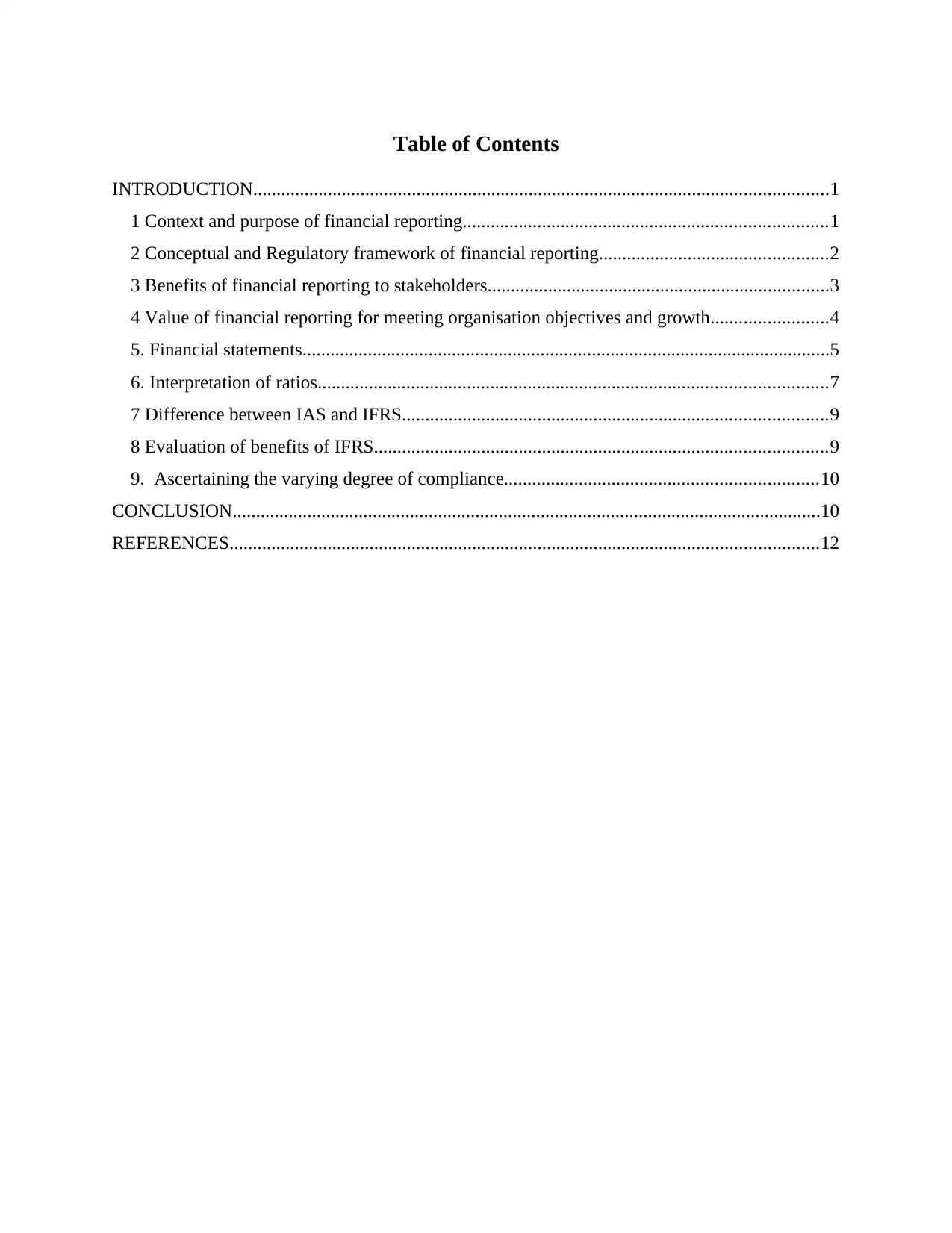
Table of Contents
INTRODUCTION...........................................................................................................................1
1 Context and purpose of financial reporting..............................................................................1
2 Conceptual and Regulatory framework of financial reporting.................................................2
3 Benefits of financial reporting to stakeholders.........................................................................3
4 Value of financial reporting for meeting organisation objectives and growth.........................4
5. Financial statements.................................................................................................................5
6. Interpretation of ratios.............................................................................................................7
7 Difference between IAS and IFRS...........................................................................................9
8 Evaluation of benefits of IFRS.................................................................................................9
9. Ascertaining the varying degree of compliance...................................................................10
CONCLUSION..............................................................................................................................10
REFERENCES..............................................................................................................................12
INTRODUCTION...........................................................................................................................1
1 Context and purpose of financial reporting..............................................................................1
2 Conceptual and Regulatory framework of financial reporting.................................................2
3 Benefits of financial reporting to stakeholders.........................................................................3
4 Value of financial reporting for meeting organisation objectives and growth.........................4
5. Financial statements.................................................................................................................5
6. Interpretation of ratios.............................................................................................................7
7 Difference between IAS and IFRS...........................................................................................9
8 Evaluation of benefits of IFRS.................................................................................................9
9. Ascertaining the varying degree of compliance...................................................................10
CONCLUSION..............................................................................................................................10
REFERENCES..............................................................................................................................12

⊘ This is a preview!⊘
Do you want full access?
Subscribe today to unlock all pages.

Trusted by 1+ million students worldwide
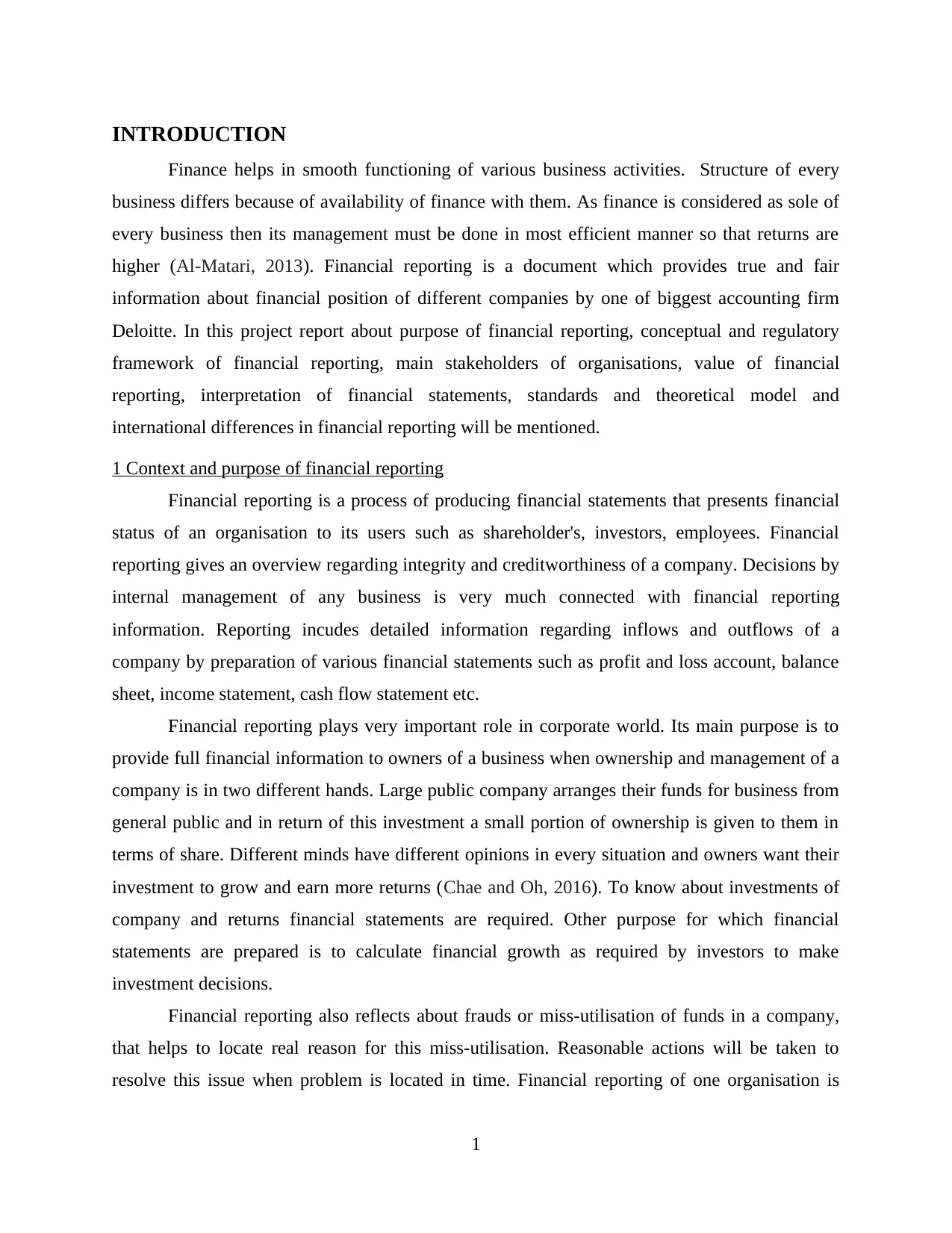
INTRODUCTION
Finance helps in smooth functioning of various business activities. Structure of every
business differs because of availability of finance with them. As finance is considered as sole of
every business then its management must be done in most efficient manner so that returns are
higher (Al-Matari, 2013). Financial reporting is a document which provides true and fair
information about financial position of different companies by one of biggest accounting firm
Deloitte. In this project report about purpose of financial reporting, conceptual and regulatory
framework of financial reporting, main stakeholders of organisations, value of financial
reporting, interpretation of financial statements, standards and theoretical model and
international differences in financial reporting will be mentioned.
1 Context and purpose of financial reporting
Financial reporting is a process of producing financial statements that presents financial
status of an organisation to its users such as shareholder's, investors, employees. Financial
reporting gives an overview regarding integrity and creditworthiness of a company. Decisions by
internal management of any business is very much connected with financial reporting
information. Reporting incudes detailed information regarding inflows and outflows of a
company by preparation of various financial statements such as profit and loss account, balance
sheet, income statement, cash flow statement etc.
Financial reporting plays very important role in corporate world. Its main purpose is to
provide full financial information to owners of a business when ownership and management of a
company is in two different hands. Large public company arranges their funds for business from
general public and in return of this investment a small portion of ownership is given to them in
terms of share. Different minds have different opinions in every situation and owners want their
investment to grow and earn more returns (Chae and Oh, 2016). To know about investments of
company and returns financial statements are required. Other purpose for which financial
statements are prepared is to calculate financial growth as required by investors to make
investment decisions.
Financial reporting also reflects about frauds or miss-utilisation of funds in a company,
that helps to locate real reason for this miss-utilisation. Reasonable actions will be taken to
resolve this issue when problem is located in time. Financial reporting of one organisation is
1
Finance helps in smooth functioning of various business activities. Structure of every
business differs because of availability of finance with them. As finance is considered as sole of
every business then its management must be done in most efficient manner so that returns are
higher (Al-Matari, 2013). Financial reporting is a document which provides true and fair
information about financial position of different companies by one of biggest accounting firm
Deloitte. In this project report about purpose of financial reporting, conceptual and regulatory
framework of financial reporting, main stakeholders of organisations, value of financial
reporting, interpretation of financial statements, standards and theoretical model and
international differences in financial reporting will be mentioned.
1 Context and purpose of financial reporting
Financial reporting is a process of producing financial statements that presents financial
status of an organisation to its users such as shareholder's, investors, employees. Financial
reporting gives an overview regarding integrity and creditworthiness of a company. Decisions by
internal management of any business is very much connected with financial reporting
information. Reporting incudes detailed information regarding inflows and outflows of a
company by preparation of various financial statements such as profit and loss account, balance
sheet, income statement, cash flow statement etc.
Financial reporting plays very important role in corporate world. Its main purpose is to
provide full financial information to owners of a business when ownership and management of a
company is in two different hands. Large public company arranges their funds for business from
general public and in return of this investment a small portion of ownership is given to them in
terms of share. Different minds have different opinions in every situation and owners want their
investment to grow and earn more returns (Chae and Oh, 2016). To know about investments of
company and returns financial statements are required. Other purpose for which financial
statements are prepared is to calculate financial growth as required by investors to make
investment decisions.
Financial reporting also reflects about frauds or miss-utilisation of funds in a company,
that helps to locate real reason for this miss-utilisation. Reasonable actions will be taken to
resolve this issue when problem is located in time. Financial reporting of one organisation is
1
Paraphrase This Document
Need a fresh take? Get an instant paraphrase of this document with our AI Paraphraser
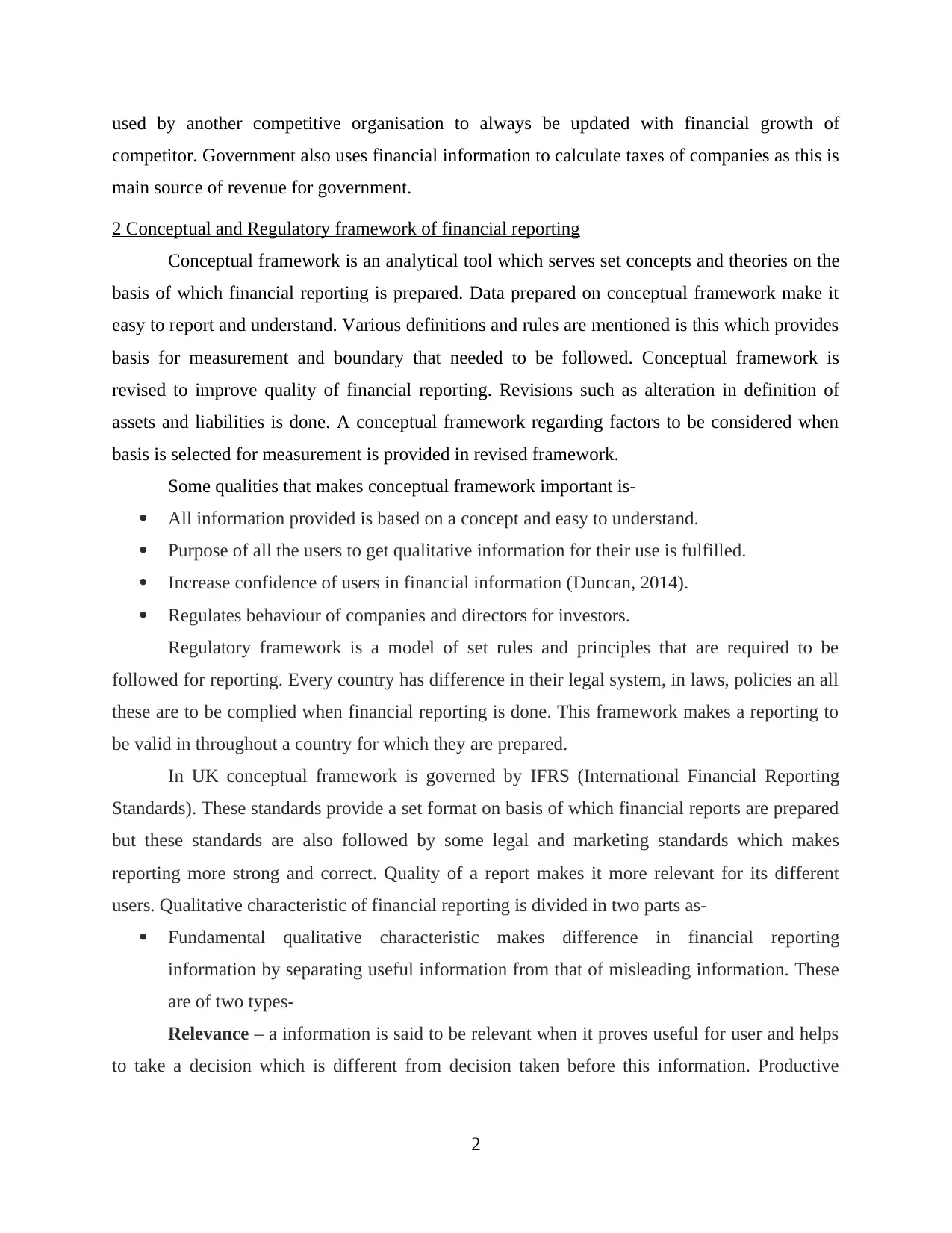
used by another competitive organisation to always be updated with financial growth of
competitor. Government also uses financial information to calculate taxes of companies as this is
main source of revenue for government.
2 Conceptual and Regulatory framework of financial reporting
Conceptual framework is an analytical tool which serves set concepts and theories on the
basis of which financial reporting is prepared. Data prepared on conceptual framework make it
easy to report and understand. Various definitions and rules are mentioned is this which provides
basis for measurement and boundary that needed to be followed. Conceptual framework is
revised to improve quality of financial reporting. Revisions such as alteration in definition of
assets and liabilities is done. A conceptual framework regarding factors to be considered when
basis is selected for measurement is provided in revised framework.
Some qualities that makes conceptual framework important is-
All information provided is based on a concept and easy to understand.
Purpose of all the users to get qualitative information for their use is fulfilled.
Increase confidence of users in financial information (Duncan, 2014).
Regulates behaviour of companies and directors for investors.
Regulatory framework is a model of set rules and principles that are required to be
followed for reporting. Every country has difference in their legal system, in laws, policies an all
these are to be complied when financial reporting is done. This framework makes a reporting to
be valid in throughout a country for which they are prepared.
In UK conceptual framework is governed by IFRS (International Financial Reporting
Standards). These standards provide a set format on basis of which financial reports are prepared
but these standards are also followed by some legal and marketing standards which makes
reporting more strong and correct. Quality of a report makes it more relevant for its different
users. Qualitative characteristic of financial reporting is divided in two parts as-
Fundamental qualitative characteristic makes difference in financial reporting
information by separating useful information from that of misleading information. These
are of two types-
Relevance – a information is said to be relevant when it proves useful for user and helps
to take a decision which is different from decision taken before this information. Productive
2
competitor. Government also uses financial information to calculate taxes of companies as this is
main source of revenue for government.
2 Conceptual and Regulatory framework of financial reporting
Conceptual framework is an analytical tool which serves set concepts and theories on the
basis of which financial reporting is prepared. Data prepared on conceptual framework make it
easy to report and understand. Various definitions and rules are mentioned is this which provides
basis for measurement and boundary that needed to be followed. Conceptual framework is
revised to improve quality of financial reporting. Revisions such as alteration in definition of
assets and liabilities is done. A conceptual framework regarding factors to be considered when
basis is selected for measurement is provided in revised framework.
Some qualities that makes conceptual framework important is-
All information provided is based on a concept and easy to understand.
Purpose of all the users to get qualitative information for their use is fulfilled.
Increase confidence of users in financial information (Duncan, 2014).
Regulates behaviour of companies and directors for investors.
Regulatory framework is a model of set rules and principles that are required to be
followed for reporting. Every country has difference in their legal system, in laws, policies an all
these are to be complied when financial reporting is done. This framework makes a reporting to
be valid in throughout a country for which they are prepared.
In UK conceptual framework is governed by IFRS (International Financial Reporting
Standards). These standards provide a set format on basis of which financial reports are prepared
but these standards are also followed by some legal and marketing standards which makes
reporting more strong and correct. Quality of a report makes it more relevant for its different
users. Qualitative characteristic of financial reporting is divided in two parts as-
Fundamental qualitative characteristic makes difference in financial reporting
information by separating useful information from that of misleading information. These
are of two types-
Relevance – a information is said to be relevant when it proves useful for user and helps
to take a decision which is different from decision taken before this information. Productive
2
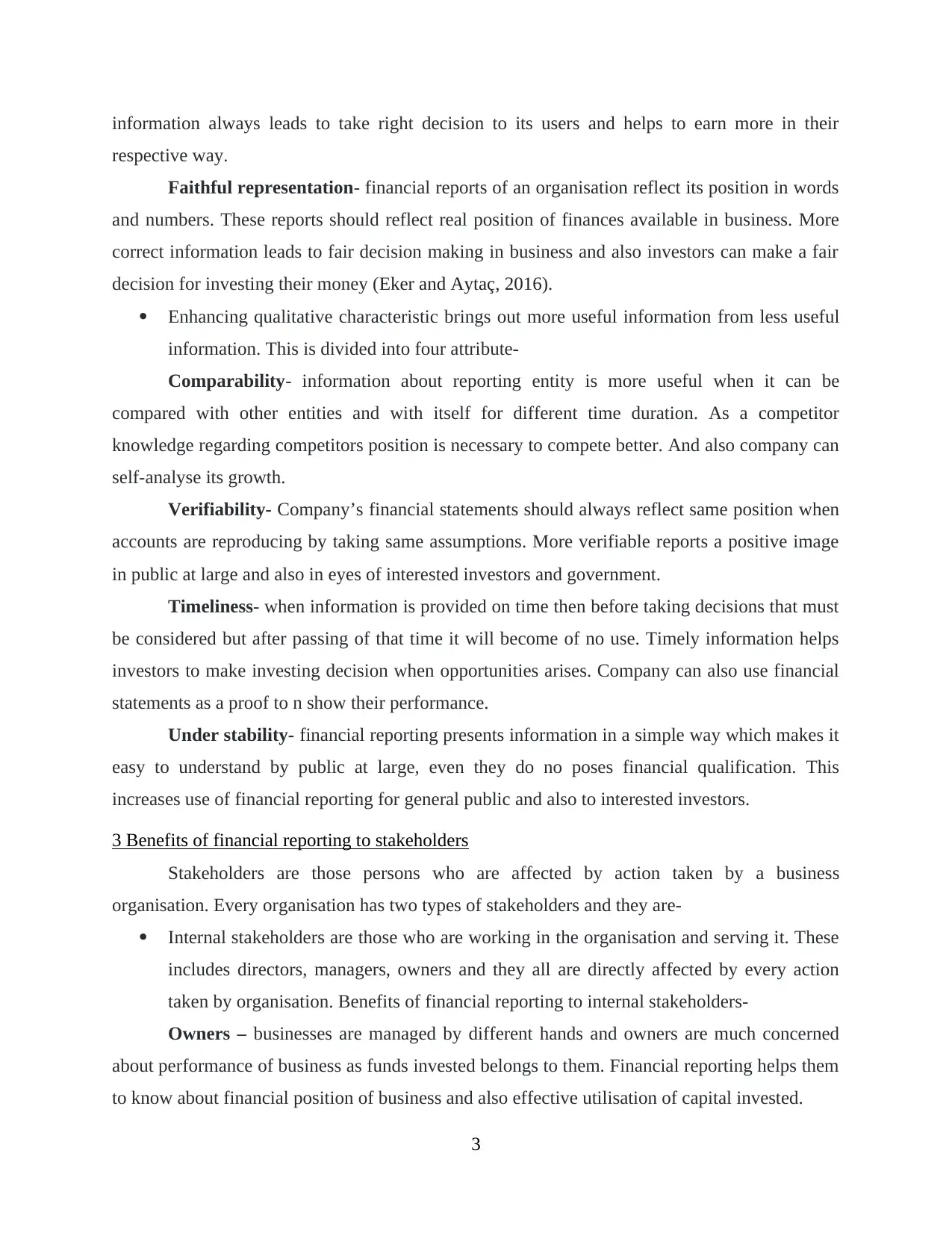
information always leads to take right decision to its users and helps to earn more in their
respective way.
Faithful representation- financial reports of an organisation reflect its position in words
and numbers. These reports should reflect real position of finances available in business. More
correct information leads to fair decision making in business and also investors can make a fair
decision for investing their money (Eker and Aytaç, 2016).
Enhancing qualitative characteristic brings out more useful information from less useful
information. This is divided into four attribute-
Comparability- information about reporting entity is more useful when it can be
compared with other entities and with itself for different time duration. As a competitor
knowledge regarding competitors position is necessary to compete better. And also company can
self-analyse its growth.
Verifiability- Company’s financial statements should always reflect same position when
accounts are reproducing by taking same assumptions. More verifiable reports a positive image
in public at large and also in eyes of interested investors and government.
Timeliness- when information is provided on time then before taking decisions that must
be considered but after passing of that time it will become of no use. Timely information helps
investors to make investing decision when opportunities arises. Company can also use financial
statements as a proof to n show their performance.
Under stability- financial reporting presents information in a simple way which makes it
easy to understand by public at large, even they do no poses financial qualification. This
increases use of financial reporting for general public and also to interested investors.
3 Benefits of financial reporting to stakeholders
Stakeholders are those persons who are affected by action taken by a business
organisation. Every organisation has two types of stakeholders and they are-
Internal stakeholders are those who are working in the organisation and serving it. These
includes directors, managers, owners and they all are directly affected by every action
taken by organisation. Benefits of financial reporting to internal stakeholders-
Owners – businesses are managed by different hands and owners are much concerned
about performance of business as funds invested belongs to them. Financial reporting helps them
to know about financial position of business and also effective utilisation of capital invested.
3
respective way.
Faithful representation- financial reports of an organisation reflect its position in words
and numbers. These reports should reflect real position of finances available in business. More
correct information leads to fair decision making in business and also investors can make a fair
decision for investing their money (Eker and Aytaç, 2016).
Enhancing qualitative characteristic brings out more useful information from less useful
information. This is divided into four attribute-
Comparability- information about reporting entity is more useful when it can be
compared with other entities and with itself for different time duration. As a competitor
knowledge regarding competitors position is necessary to compete better. And also company can
self-analyse its growth.
Verifiability- Company’s financial statements should always reflect same position when
accounts are reproducing by taking same assumptions. More verifiable reports a positive image
in public at large and also in eyes of interested investors and government.
Timeliness- when information is provided on time then before taking decisions that must
be considered but after passing of that time it will become of no use. Timely information helps
investors to make investing decision when opportunities arises. Company can also use financial
statements as a proof to n show their performance.
Under stability- financial reporting presents information in a simple way which makes it
easy to understand by public at large, even they do no poses financial qualification. This
increases use of financial reporting for general public and also to interested investors.
3 Benefits of financial reporting to stakeholders
Stakeholders are those persons who are affected by action taken by a business
organisation. Every organisation has two types of stakeholders and they are-
Internal stakeholders are those who are working in the organisation and serving it. These
includes directors, managers, owners and they all are directly affected by every action
taken by organisation. Benefits of financial reporting to internal stakeholders-
Owners – businesses are managed by different hands and owners are much concerned
about performance of business as funds invested belongs to them. Financial reporting helps them
to know about financial position of business and also effective utilisation of capital invested.
3
⊘ This is a preview!⊘
Do you want full access?
Subscribe today to unlock all pages.

Trusted by 1+ million students worldwide
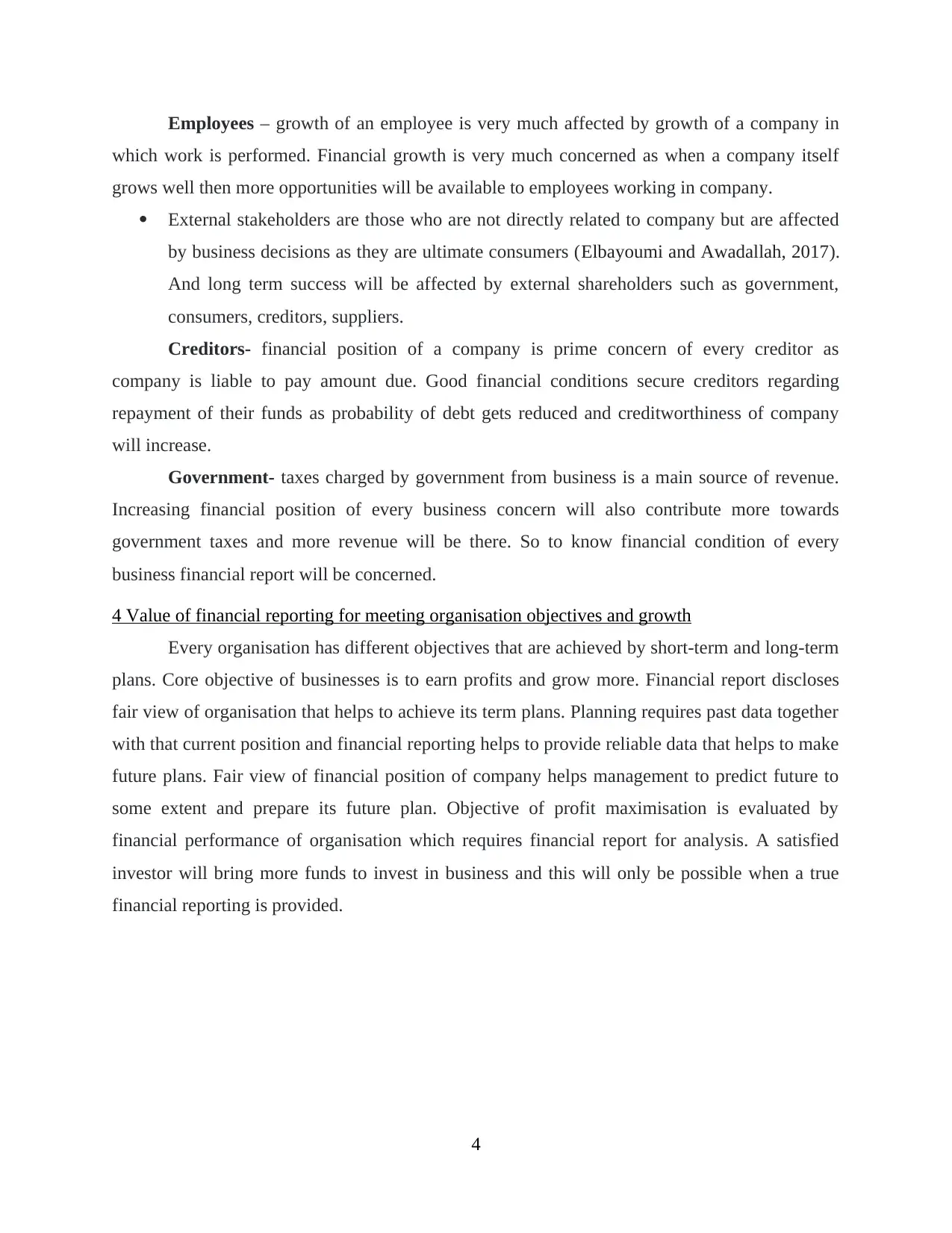
Employees – growth of an employee is very much affected by growth of a company in
which work is performed. Financial growth is very much concerned as when a company itself
grows well then more opportunities will be available to employees working in company.
External stakeholders are those who are not directly related to company but are affected
by business decisions as they are ultimate consumers (Elbayoumi and Awadallah, 2017).
And long term success will be affected by external shareholders such as government,
consumers, creditors, suppliers.
Creditors- financial position of a company is prime concern of every creditor as
company is liable to pay amount due. Good financial conditions secure creditors regarding
repayment of their funds as probability of debt gets reduced and creditworthiness of company
will increase.
Government- taxes charged by government from business is a main source of revenue.
Increasing financial position of every business concern will also contribute more towards
government taxes and more revenue will be there. So to know financial condition of every
business financial report will be concerned.
4 Value of financial reporting for meeting organisation objectives and growth
Every organisation has different objectives that are achieved by short-term and long-term
plans. Core objective of businesses is to earn profits and grow more. Financial report discloses
fair view of organisation that helps to achieve its term plans. Planning requires past data together
with that current position and financial reporting helps to provide reliable data that helps to make
future plans. Fair view of financial position of company helps management to predict future to
some extent and prepare its future plan. Objective of profit maximisation is evaluated by
financial performance of organisation which requires financial report for analysis. A satisfied
investor will bring more funds to invest in business and this will only be possible when a true
financial reporting is provided.
4
which work is performed. Financial growth is very much concerned as when a company itself
grows well then more opportunities will be available to employees working in company.
External stakeholders are those who are not directly related to company but are affected
by business decisions as they are ultimate consumers (Elbayoumi and Awadallah, 2017).
And long term success will be affected by external shareholders such as government,
consumers, creditors, suppliers.
Creditors- financial position of a company is prime concern of every creditor as
company is liable to pay amount due. Good financial conditions secure creditors regarding
repayment of their funds as probability of debt gets reduced and creditworthiness of company
will increase.
Government- taxes charged by government from business is a main source of revenue.
Increasing financial position of every business concern will also contribute more towards
government taxes and more revenue will be there. So to know financial condition of every
business financial report will be concerned.
4 Value of financial reporting for meeting organisation objectives and growth
Every organisation has different objectives that are achieved by short-term and long-term
plans. Core objective of businesses is to earn profits and grow more. Financial report discloses
fair view of organisation that helps to achieve its term plans. Planning requires past data together
with that current position and financial reporting helps to provide reliable data that helps to make
future plans. Fair view of financial position of company helps management to predict future to
some extent and prepare its future plan. Objective of profit maximisation is evaluated by
financial performance of organisation which requires financial report for analysis. A satisfied
investor will bring more funds to invest in business and this will only be possible when a true
financial reporting is provided.
4
Paraphrase This Document
Need a fresh take? Get an instant paraphrase of this document with our AI Paraphraser
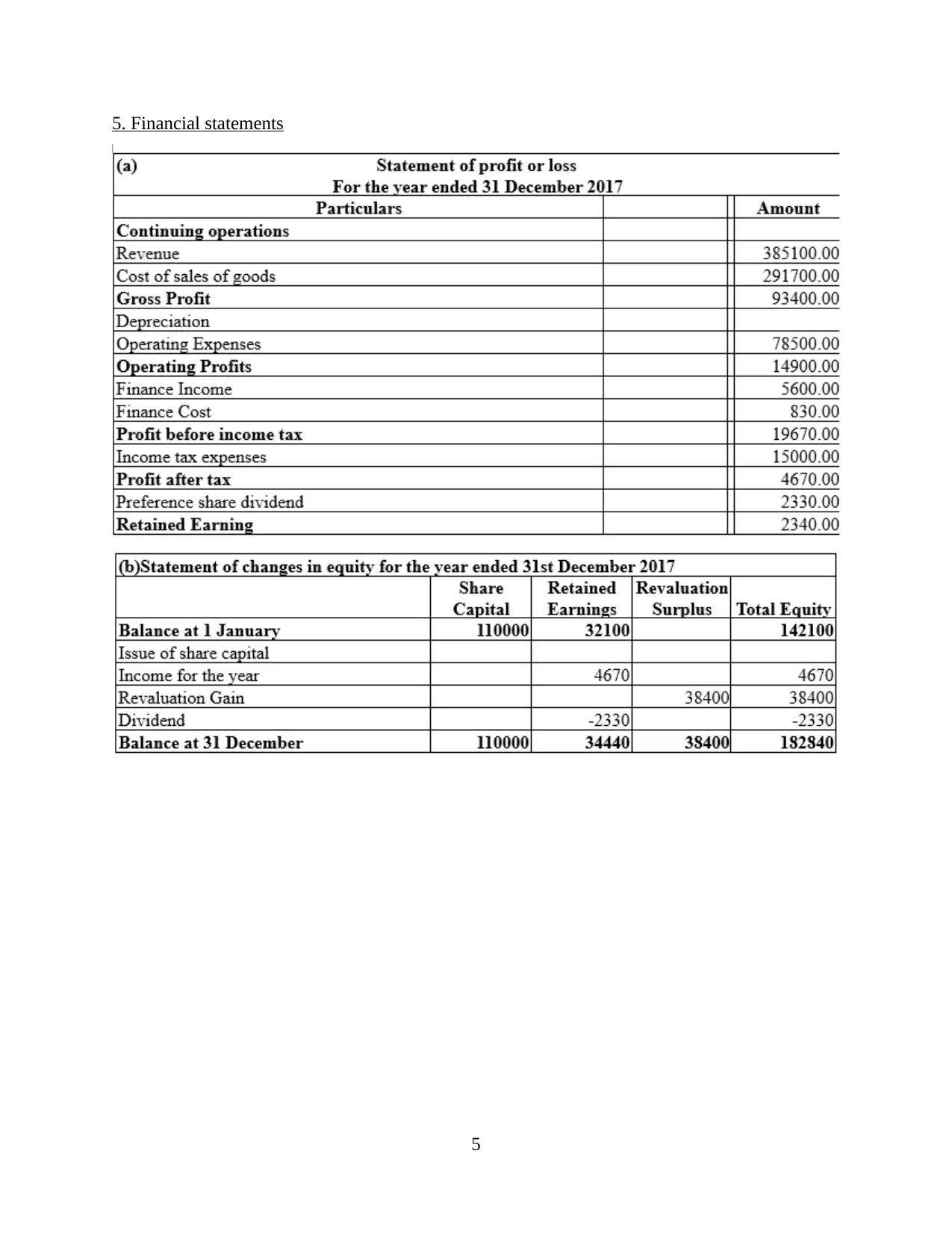
5. Financial statements
5
5
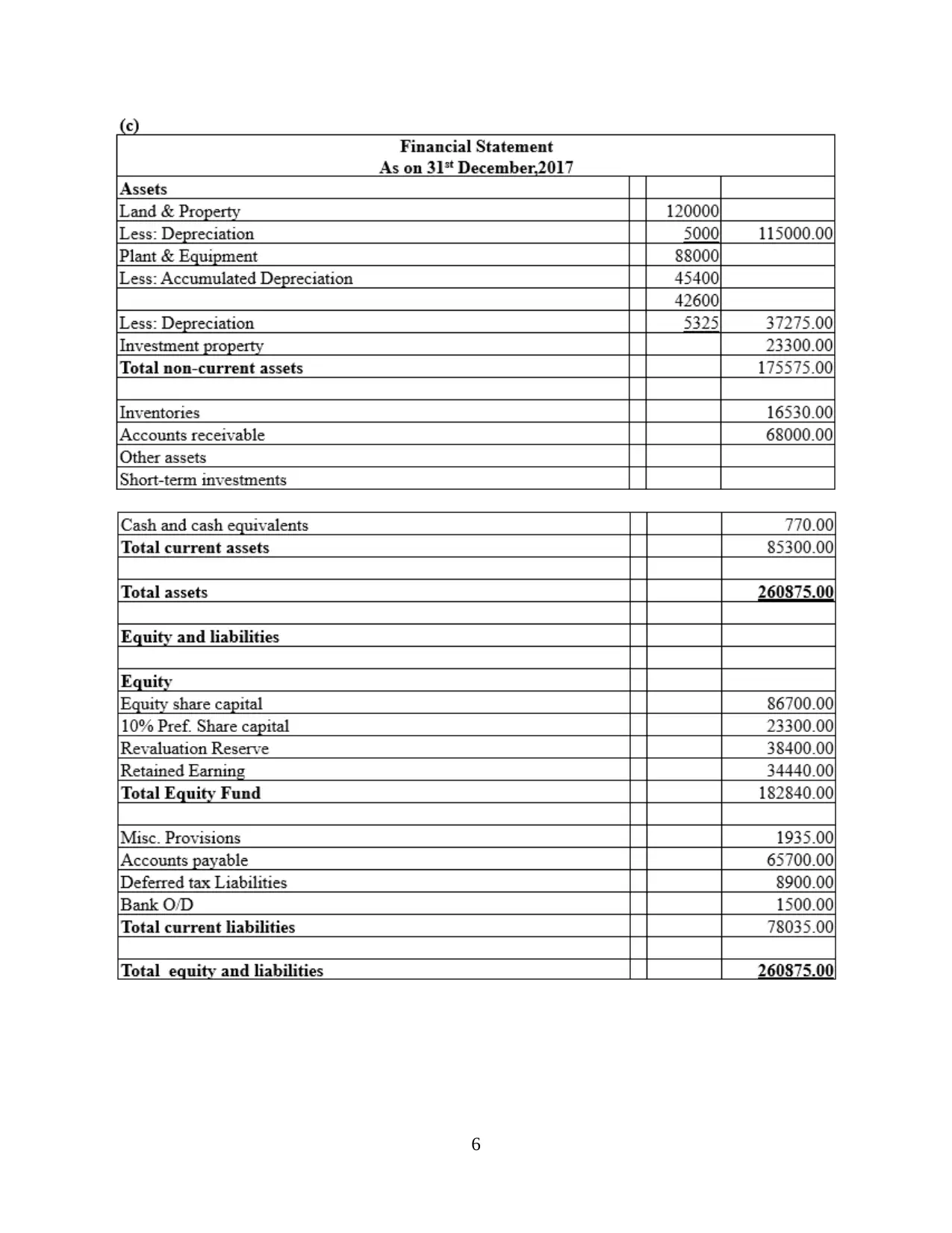
6
⊘ This is a preview!⊘
Do you want full access?
Subscribe today to unlock all pages.

Trusted by 1+ million students worldwide
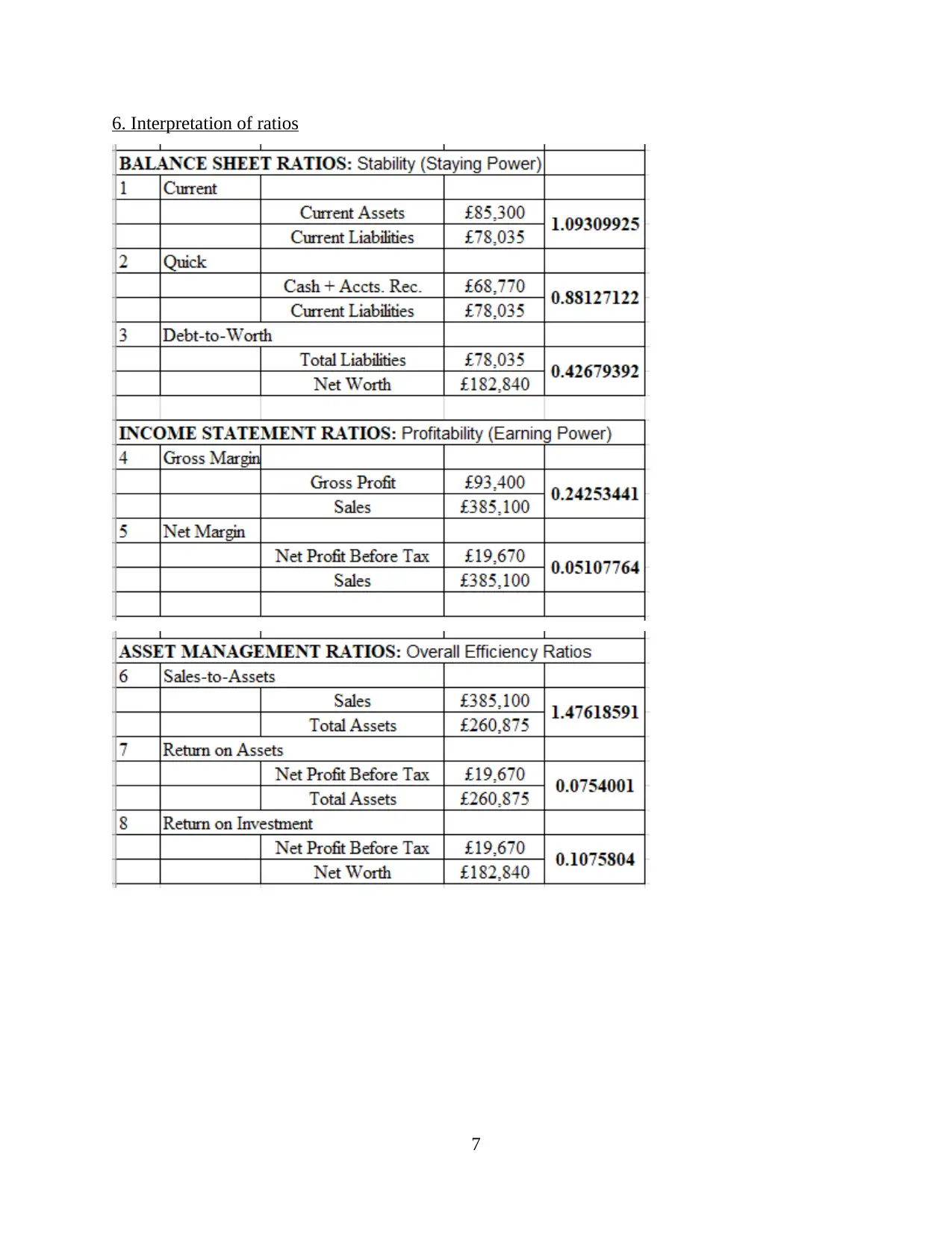
6. Interpretation of ratios
7
7
Paraphrase This Document
Need a fresh take? Get an instant paraphrase of this document with our AI Paraphraser
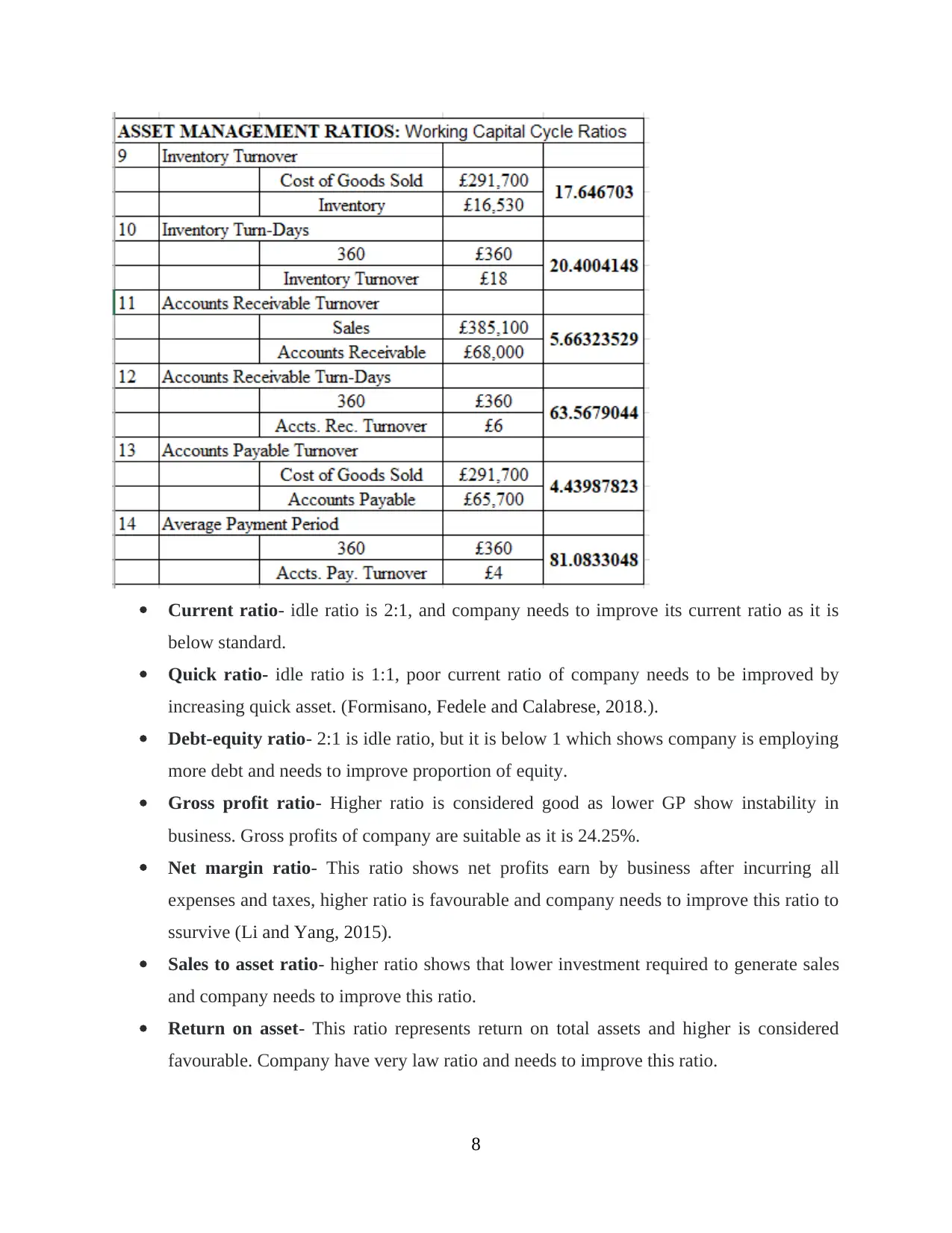
Current ratio- idle ratio is 2:1, and company needs to improve its current ratio as it is
below standard.
Quick ratio- idle ratio is 1:1, poor current ratio of company needs to be improved by
increasing quick asset. (Formisano, Fedele and Calabrese, 2018.).
Debt-equity ratio- 2:1 is idle ratio, but it is below 1 which shows company is employing
more debt and needs to improve proportion of equity.
Gross profit ratio- Higher ratio is considered good as lower GP show instability in
business. Gross profits of company are suitable as it is 24.25%.
Net margin ratio- This ratio shows net profits earn by business after incurring all
expenses and taxes, higher ratio is favourable and company needs to improve this ratio to
ssurvive (Li and Yang, 2015).
Sales to asset ratio- higher ratio shows that lower investment required to generate sales
and company needs to improve this ratio.
Return on asset- This ratio represents return on total assets and higher is considered
favourable. Company have very law ratio and needs to improve this ratio.
8
below standard.
Quick ratio- idle ratio is 1:1, poor current ratio of company needs to be improved by
increasing quick asset. (Formisano, Fedele and Calabrese, 2018.).
Debt-equity ratio- 2:1 is idle ratio, but it is below 1 which shows company is employing
more debt and needs to improve proportion of equity.
Gross profit ratio- Higher ratio is considered good as lower GP show instability in
business. Gross profits of company are suitable as it is 24.25%.
Net margin ratio- This ratio shows net profits earn by business after incurring all
expenses and taxes, higher ratio is favourable and company needs to improve this ratio to
ssurvive (Li and Yang, 2015).
Sales to asset ratio- higher ratio shows that lower investment required to generate sales
and company needs to improve this ratio.
Return on asset- This ratio represents return on total assets and higher is considered
favourable. Company have very law ratio and needs to improve this ratio.
8
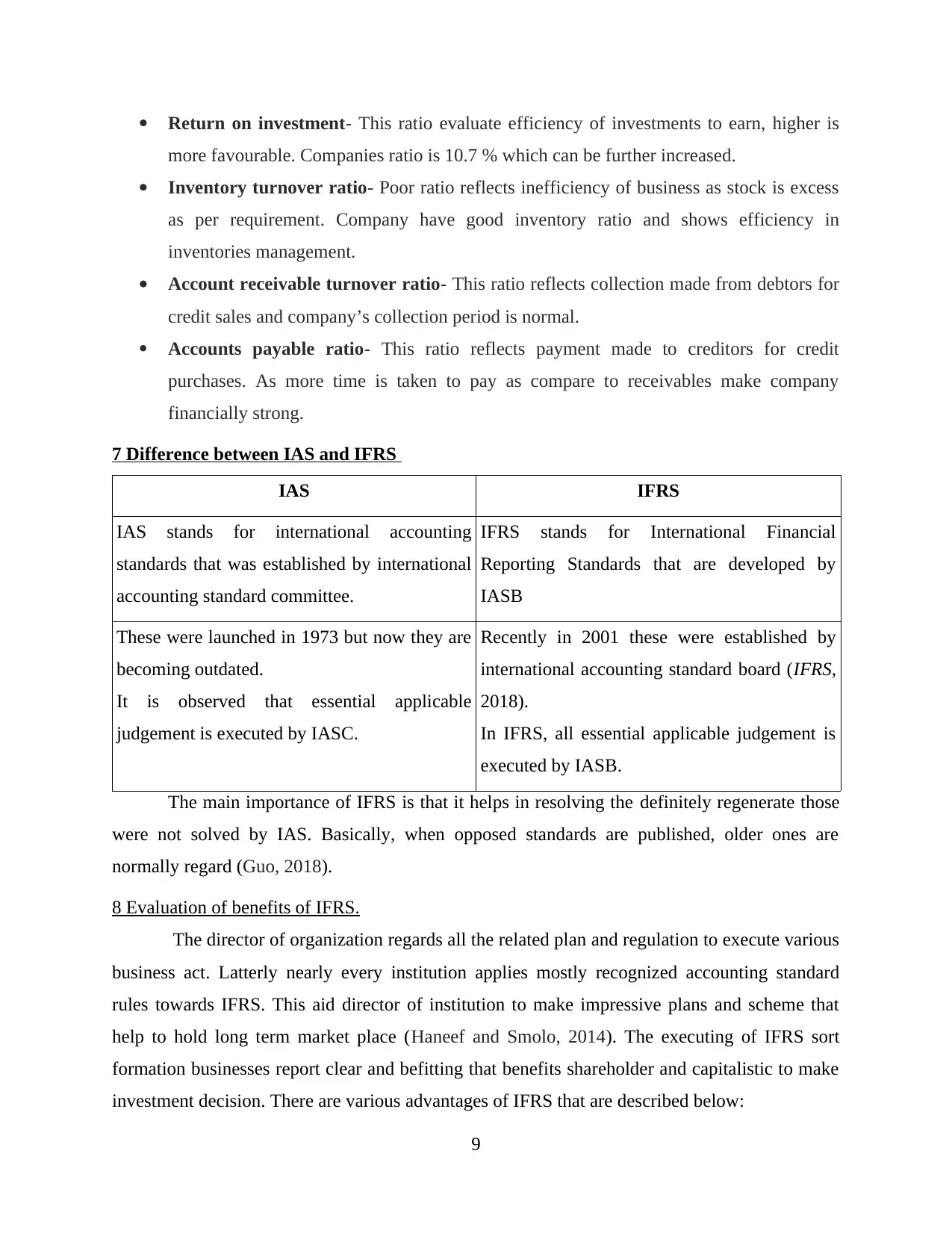
Return on investment- This ratio evaluate efficiency of investments to earn, higher is
more favourable. Companies ratio is 10.7 % which can be further increased.
Inventory turnover ratio- Poor ratio reflects inefficiency of business as stock is excess
as per requirement. Company have good inventory ratio and shows efficiency in
inventories management.
Account receivable turnover ratio- This ratio reflects collection made from debtors for
credit sales and company’s collection period is normal.
Accounts payable ratio- This ratio reflects payment made to creditors for credit
purchases. As more time is taken to pay as compare to receivables make company
financially strong.
7 Difference between IAS and IFRS
IAS IFRS
IAS stands for international accounting
standards that was established by international
accounting standard committee.
IFRS stands for International Financial
Reporting Standards that are developed by
IASB
These were launched in 1973 but now they are
becoming outdated.
It is observed that essential applicable
judgement is executed by IASC.
Recently in 2001 these were established by
international accounting standard board (IFRS,
2018).
In IFRS, all essential applicable judgement is
executed by IASB.
The main importance of IFRS is that it helps in resolving the definitely regenerate those
were not solved by IAS. Basically, when opposed standards are published, older ones are
normally regard (Guo, 2018).
8 Evaluation of benefits of IFRS.
The director of organization regards all the related plan and regulation to execute various
business act. Latterly nearly every institution applies mostly recognized accounting standard
rules towards IFRS. This aid director of institution to make impressive plans and scheme that
help to hold long term market place (Haneef and Smolo, 2014). The executing of IFRS sort
formation businesses report clear and befitting that benefits shareholder and capitalistic to make
investment decision. There are various advantages of IFRS that are described below:
9
more favourable. Companies ratio is 10.7 % which can be further increased.
Inventory turnover ratio- Poor ratio reflects inefficiency of business as stock is excess
as per requirement. Company have good inventory ratio and shows efficiency in
inventories management.
Account receivable turnover ratio- This ratio reflects collection made from debtors for
credit sales and company’s collection period is normal.
Accounts payable ratio- This ratio reflects payment made to creditors for credit
purchases. As more time is taken to pay as compare to receivables make company
financially strong.
7 Difference between IAS and IFRS
IAS IFRS
IAS stands for international accounting
standards that was established by international
accounting standard committee.
IFRS stands for International Financial
Reporting Standards that are developed by
IASB
These were launched in 1973 but now they are
becoming outdated.
It is observed that essential applicable
judgement is executed by IASC.
Recently in 2001 these were established by
international accounting standard board (IFRS,
2018).
In IFRS, all essential applicable judgement is
executed by IASB.
The main importance of IFRS is that it helps in resolving the definitely regenerate those
were not solved by IAS. Basically, when opposed standards are published, older ones are
normally regard (Guo, 2018).
8 Evaluation of benefits of IFRS.
The director of organization regards all the related plan and regulation to execute various
business act. Latterly nearly every institution applies mostly recognized accounting standard
rules towards IFRS. This aid director of institution to make impressive plans and scheme that
help to hold long term market place (Haneef and Smolo, 2014). The executing of IFRS sort
formation businesses report clear and befitting that benefits shareholder and capitalistic to make
investment decision. There are various advantages of IFRS that are described below:
9
⊘ This is a preview!⊘
Do you want full access?
Subscribe today to unlock all pages.

Trusted by 1+ million students worldwide
1 out of 15
Related Documents
Your All-in-One AI-Powered Toolkit for Academic Success.
+13062052269
info@desklib.com
Available 24*7 on WhatsApp / Email
![[object Object]](/_next/static/media/star-bottom.7253800d.svg)
Unlock your academic potential
Copyright © 2020–2025 A2Z Services. All Rights Reserved. Developed and managed by ZUCOL.





